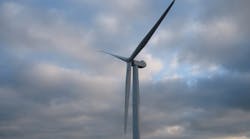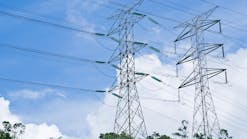Stanford Scientists Calculate Energy Required to Store Wind and Solar Power on the Grid
Renewable energy holds the promise of reducing carbon dioxide emissions. But there are times when solar and wind farms generate more electricity than is needed by consumers. Storing that surplus energy in batteries for later use seems like an obvious solution, but a new study from Stanford University suggests that might not always be the case.
"We looked at batteries and other promising technologies for storing solar and wind energy on the electrical grid," said Charles Barnhart, the lead author of the study and a postdoctoral scholar at Stanford's Global Climate and Energy Project (GCEP).
"Our primary goal was to calculate their overall energetic cost – that is, the total amount of fuel and electricity required to build and operate these storage technologies. We found that when you factor in the energetic costs, grid-scale batteries make sense for storing surplus solar energy, but not for wind."
The study, which is supported by GCEP, is published in the online edition of the journal Energy and Environmental Science.
Climate change and renewable energy
Most electricity in the United States is generated at power plants that run on coal and natural gas – fossil fuels that contribute significantly to global warming by emitting large amounts of carbon dioxide. Solar and wind power are emissions-free and renewable, but depend on sunlight or wind to operate.
"For the grid to function efficiently, power supply needs to match power demand at all times, but with renewables, that's not always the case," Barnhart said. "For example, wind farms sometimes produce too much electricity at night when demand is low. That excess energy has to be stored or used elsewhere. Otherwise it will be lost. However, the U.S. grid has very limited storage capacity."
A wide variety of technologies are being developed to address the lack of grid-scale storage. The Stanford team looked at several emerging technologies, including five battery types – lead-acid, lithium-ion, sodium-sulfur, vanadium-redox and zinc-bromine.
In a previous study, Barnhart calculated the energetic cost of building and maintaining each of the five battery systems for grid-scale storage. Lead-acid batteries had the highest energetic cost, lithium-ion the lowest, he found.
"We calculated how much energy is used over the full lifecycle of the battery – from the mining of raw materials to the installation of the finished device," Barnhart said. "Batteries with high energetic cost consume more fossil fuels and therefore release more carbon dioxide over their lifetime. If a battery's energetic cost is too high, its overall contribution to global warming could negate the environmental benefits of the wind or solar farm it was supposed to support."
For this study, he and his colleagues calculated the energetic cost of grid-scale photovoltaic solar cells and wind turbines.
"Both wind turbines and photovoltaics deliver more energy than it takes to build and maintain them," said GCEP postdoctoral scholar Michael Dale, a co-author of the study. "However, our calculations showed that the overall energetic cost of wind turbines is much lower than conventional solar panels, which require lots of energy, primarily from fossil fuels, for processing silicon and fabricating other components."
To store or curtail?
Next, the scientists looked at the energetic cost of curtailment – the practice of shutting down solar panels and wind turbines to reduce the production of surplus electricity on the grid.
"Curtailment of renewable resources seems wasteful," Barnhart said. "But grid operators routinely curtail wind turbines to avoid a sudden, unexpected surge of excess electricity that could overload transmission lines and cause blackouts. Curtailment rates in the U.S. will likely increase as renewable energy becomes more prevalent."
Shutting down a clean source of electricity seems counterproductive, but is storing surplus energy in batteries a practical alternative?
To find out, the researchers compared the energetic cost of curtailing solar and wind power versus the energetic cost of grid-scale storage. Their calculations were based on a formula known as "energy return on investment" – the amount of energy produced by a technology, divided by the amount of energy it takes to build and maintain that technology.
Using that formula, the researchers calculated that the amount of energy required to create a solar farm is comparable to the energy used to build each of the five battery technologies. "Using batteries to store solar power during periods of low demand would, therefore, be energetically favorable," Dale said.
The results were quite different for wind farms. The scientists found that curtailing wind power reduces the energy return on investment by 10 percent. But storing surplus wind-generated electricity in batteries results in even greater reductions – from about 20 percent for lithium-ion batteries to more than 50 percent for lead-acid.
"Ideally, the energetic cost of curtailing a resource should at least equal the amount of energy it cost to store it," Dale said. "That's the case for photovoltaics, but for wind farms, the energetic cost of curtailment is much lower than for battery storage. Therefore, it would actually be more energetically efficient to shut down a wind turbine than to store the surplus electricity it generates."
He compared it to buying a safe. "You wouldn't spend a $100 on a safe to store a $10 watch," he said. "Likewise, it's not sensible to build energetically expensive batteries for an energetically cheap resource like wind, but it does make sense for photovoltaic systems, which require lots of energy to produce."
Increasing the cycle life of a battery would be the most effective way to improve its energetic performance, Barnhart added. Conventional lithium-ion batteries last about four years, or 6,000 charge-discharge cycles. Lead-acid batteries only last about 700 cycles. To efficiently store energy on the grid, batteries must endure 10,000 to 18,000 cycles, he said.
"Storing energy consumes energy, and curtailing energy wastes it," Barnhart said. "In either case, the result is a reduction in the overall energy return on investment."
Other options
In addition to batteries, the researchers considered other technologies for storing renewable energy, such as pumped hydroelectric storage, which uses surplus electricity to pump water to a reservoir behind a dam. Later, when demand for energy is high, the stored water is released through turbines in the dam to generate electricity.
"Pumped hydro is used in 99 percent of grid storage today, " Barnhart said. "It works fantastically from an energetic perspective for both wind and solar. Its energy return on investment is 10 times better than conventional batteries. But there are geologic and environmental constraints on where pumped hydro can be deployed."
Storage is not the only way to improve grid reliability. "Energy that would otherwise be lost during times of excess could be used to pump water for irrigation or to charge a fleet of electric vehicles, for example," Dale said.
It's important for society to be energy-smart about implementing new technologies, Barnhart added. "Policymakers and investors need to consider the energetic cost as well as the financial cost of new technologies," he said. "If economics is the sole focus, then less expensive technologies that require significant amounts of energy for their manufacture, maintenance and replacement might win out – even if they ultimately increase greenhouse gas emissions and negate the long-term benefits of implementing wind and solar power."
"Our goal is to understand what's needed to build a scalable low-carbon energy system," said co-author Sally Benson, the director of GCEP and a professor of energy resources engineering. "Energy return on investment is one of those metrics that sheds light on potential roadblocks. Hopefully this study will provide a performance target to guide future research on grid-scale energy storage."
Adam Brandt, an assistant professor of energy resources engineering in Stanford's School of Earth Sciences, also co-authored the study.


